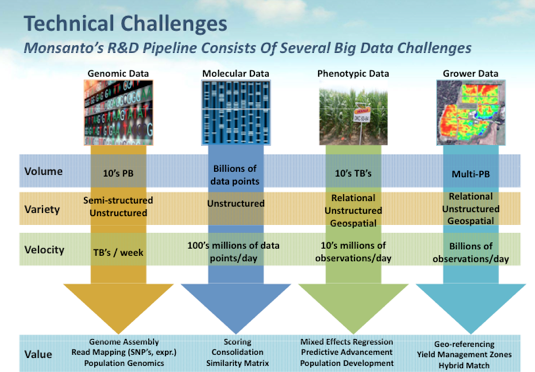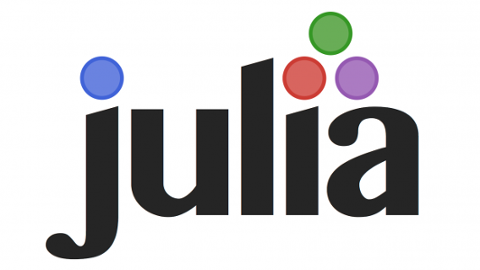
Monsanto is more infamous for
growing its genetically modified crops than its use of software, but a series of corporate acquisitions and a new emphasis on tech solutions has transformed it into a firm that acts more like an innovative IT vendor than an agribusiness giant. They are a good example of how
agribusiness companies are getting interested in data analytics. Before an audience of entrepreneurs and civic leaders at a downtown St. Louis tech incubator entitled, "The Role of IT in Modern Agriculture," Jim McCarter (the Entrepreneur in Residence for Monsanto) reviewed where the company’s IT efforts are going. Before he came to Monsanto less than two years ago, McCarter ran his own biotech startup, where he developed pest control molecules. He is also is a genetics professor at Washington University. One of Monsanto’s goals is to produce crops that can double their yields by 2030. That focus on productivity and sustainable agriculture pervades the company’s culture—as well as the data analytics underlying it. "IT is becoming increasingly central to what we do, and we are integrating IT into all aspects of our business now," McCarter said. "Monsanto has become a data-driven culture." The proof is how much data the company tracks on a regular basis (see Monsanto's chart above). Monsanto’s core projects generate huge amounts of bits, especially its genomic efforts, which are the focus of so much public attention. Other big data gobblers are the phenotypes of millions of DNA structures that describe the various biological properties of each plant, and the photographic imagery of crop fields. All told, there are several tens of petabytes that need storage and analysis, a number that’s doubling roughly every 16 months. As a result, Monsanto has become a big user of Hadoop, H Base and other analytics-and-storage tools. The company is headquartered in St. Louis, with more than 21,000 employees in 500 different locations around the globe. About 5,000 of those employees are engaged in basic research and development, and the company is investing about $1.4 billion in research and development each year. That’s not at IBM or Microsoft levels, but it’s an impressive figure for a company that just a few years ago didn't have many IT-related employees. With all that tech muscle, the company has launched IT-based initiatives such as FarmCare, which sends mobile phone alerts about real-time weather threats to farmers, and North Star, a global supply chain transportation management system that has saved millions of dollars in overhead costs. Monsanto isn't trying to go at this alone. They’ve partnering up with other firms in specialized areas such as remote imaging, high performance computing and computational biology.
FieldScripts
Monsanto has also grown over the last several years via acquisitions.
Last year it purchased Precision Planting, which uses software to support farming techniques; those assets will form the first of Monsanto's efforts in what it calls Integrated Farming Systems and its
FieldScripts software. FieldScripts uses proprietary algorithms (fed with data from the FieldScripts Testing Network and Monsanto research) to recommend where to best plant corn hybrids. The software tool will be released next year. "Just like Amazon has its recommendation engine for what book to buy, we will have our recommendations of what and how a grower should plant a particular crop," said McCarter. "All fields aren't uniform and shouldn't be planted uniformly either.” FieldScripts is the first in an evolution of farming software tools that will provide a lot more intelligence and real-time information to farmers. In the past, farmers stored their agronomic data on USB sticks that they mailed to Monsanto for analysis—a cumbersome process, to say the least. Now the cloud has become part of the equation, with Monsanto considering how to best leverage the growth in mobile connections to send data from a farm for analysis. "In the past year or so, rural cellular usage and smartphone access has caught up with more urban areas," McCarter added. "Farmers are very data driven," said Erich Hochmuth, the data analysis architecture lead for Monsanto. "And when they hear that they can improve their crop yields by anywhere from five to ten bushels per acre, that gets their attention. That can add up, and can be a big motivation for farmers to adopt our technology." Just building software isn't enough for Monsanto, which wants to become more of a presence in the venture-capital arena. Its Growth Ventures division was launched last year, with offices in St. Louis, Boston and San Francisco; the company plans to fund $150 million in startups, mostly in IT and biotech. In Boston, they have partnered with Atlas Ventures on funding several startup ventures already. "We weren't heavily plugged into the VC community and wanted to participate at the earliest stages for seed and A round funding," McCarter said. Despite its increasingly sophisticated use of data analytics in the name of greater crop yields, however, Monsanto faces pushback from various groups with an aversion to genetically modified food; a
current ballot initiative in Washington State, for example, could result in genetically modified foods needing a label in order to go on sale here. The company has also inspired a
“March Against Monsanto,” which has been much in the news lately.
Image: Monsanto Corp.

 Monsanto is more infamous for growing its genetically modified crops than its use of software, but a series of corporate acquisitions and a new emphasis on tech solutions has transformed it into a firm that acts more like an innovative IT vendor than an agribusiness giant. They are a good example of how agribusiness companies are getting interested in data analytics. Before an audience of entrepreneurs and civic leaders at a downtown St. Louis tech incubator entitled, "The Role of IT in Modern Agriculture," Jim McCarter (the Entrepreneur in Residence for Monsanto) reviewed where the company’s IT efforts are going. Before he came to Monsanto less than two years ago, McCarter ran his own biotech startup, where he developed pest control molecules. He is also is a genetics professor at Washington University. One of Monsanto’s goals is to produce crops that can double their yields by 2030. That focus on productivity and sustainable agriculture pervades the company’s culture—as well as the data analytics underlying it. "IT is becoming increasingly central to what we do, and we are integrating IT into all aspects of our business now," McCarter said. "Monsanto has become a data-driven culture." The proof is how much data the company tracks on a regular basis (see Monsanto's chart above). Monsanto’s core projects generate huge amounts of bits, especially its genomic efforts, which are the focus of so much public attention. Other big data gobblers are the phenotypes of millions of DNA structures that describe the various biological properties of each plant, and the photographic imagery of crop fields. All told, there are several tens of petabytes that need storage and analysis, a number that’s doubling roughly every 16 months. As a result, Monsanto has become a big user of Hadoop, H Base and other analytics-and-storage tools. The company is headquartered in St. Louis, with more than 21,000 employees in 500 different locations around the globe. About 5,000 of those employees are engaged in basic research and development, and the company is investing about $1.4 billion in research and development each year. That’s not at IBM or Microsoft levels, but it’s an impressive figure for a company that just a few years ago didn't have many IT-related employees. With all that tech muscle, the company has launched IT-based initiatives such as FarmCare, which sends mobile phone alerts about real-time weather threats to farmers, and North Star, a global supply chain transportation management system that has saved millions of dollars in overhead costs. Monsanto isn't trying to go at this alone. They’ve partnering up with other firms in specialized areas such as remote imaging, high performance computing and computational biology.
Monsanto is more infamous for growing its genetically modified crops than its use of software, but a series of corporate acquisitions and a new emphasis on tech solutions has transformed it into a firm that acts more like an innovative IT vendor than an agribusiness giant. They are a good example of how agribusiness companies are getting interested in data analytics. Before an audience of entrepreneurs and civic leaders at a downtown St. Louis tech incubator entitled, "The Role of IT in Modern Agriculture," Jim McCarter (the Entrepreneur in Residence for Monsanto) reviewed where the company’s IT efforts are going. Before he came to Monsanto less than two years ago, McCarter ran his own biotech startup, where he developed pest control molecules. He is also is a genetics professor at Washington University. One of Monsanto’s goals is to produce crops that can double their yields by 2030. That focus on productivity and sustainable agriculture pervades the company’s culture—as well as the data analytics underlying it. "IT is becoming increasingly central to what we do, and we are integrating IT into all aspects of our business now," McCarter said. "Monsanto has become a data-driven culture." The proof is how much data the company tracks on a regular basis (see Monsanto's chart above). Monsanto’s core projects generate huge amounts of bits, especially its genomic efforts, which are the focus of so much public attention. Other big data gobblers are the phenotypes of millions of DNA structures that describe the various biological properties of each plant, and the photographic imagery of crop fields. All told, there are several tens of petabytes that need storage and analysis, a number that’s doubling roughly every 16 months. As a result, Monsanto has become a big user of Hadoop, H Base and other analytics-and-storage tools. The company is headquartered in St. Louis, with more than 21,000 employees in 500 different locations around the globe. About 5,000 of those employees are engaged in basic research and development, and the company is investing about $1.4 billion in research and development each year. That’s not at IBM or Microsoft levels, but it’s an impressive figure for a company that just a few years ago didn't have many IT-related employees. With all that tech muscle, the company has launched IT-based initiatives such as FarmCare, which sends mobile phone alerts about real-time weather threats to farmers, and North Star, a global supply chain transportation management system that has saved millions of dollars in overhead costs. Monsanto isn't trying to go at this alone. They’ve partnering up with other firms in specialized areas such as remote imaging, high performance computing and computational biology.
